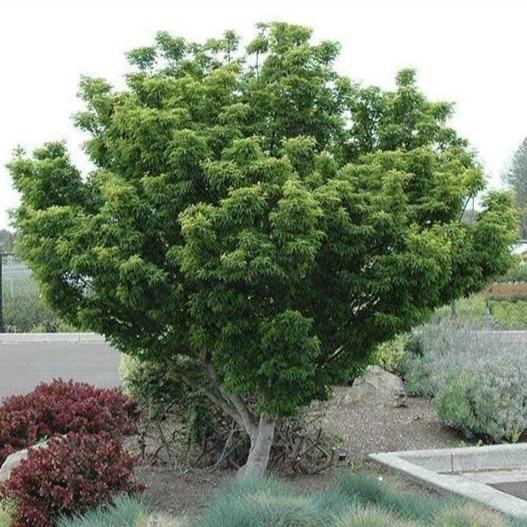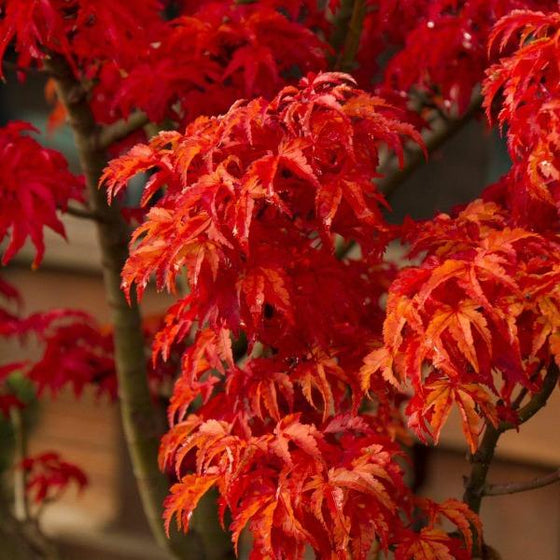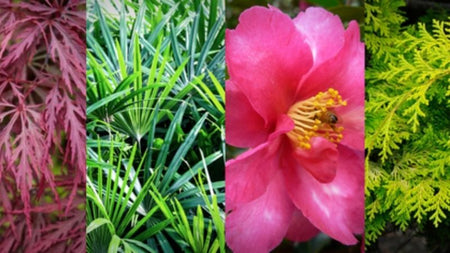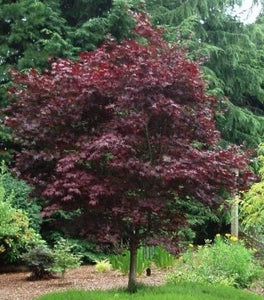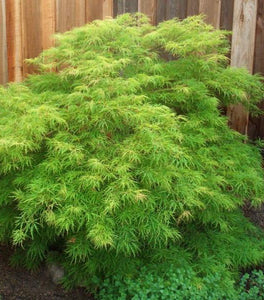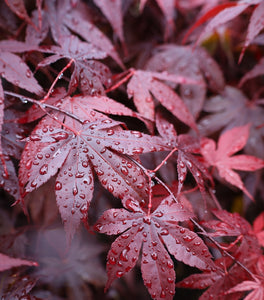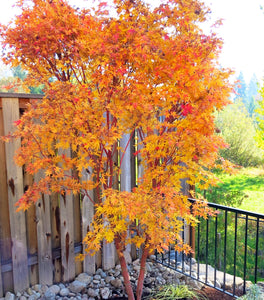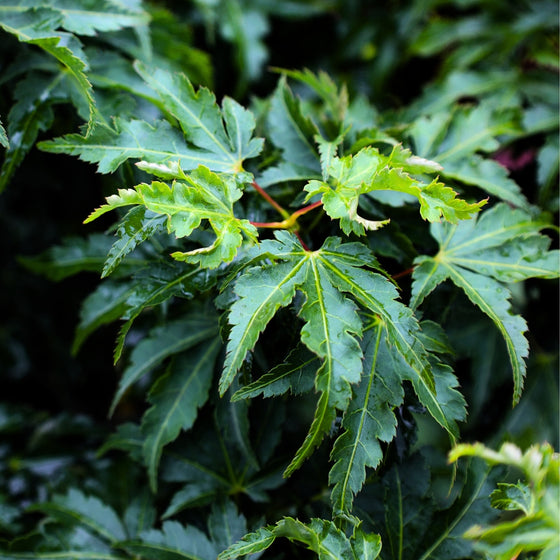
Images Depict Mature Plants
Lion’s Head Japanese Maple for Sale Online
Lion’s Head Japanese Maple (Acer palmatum ‘Shishigashira’) is a striking and unique ornamental tree prized for its dense, crinkled foliage and upright, compact growth habit. Unlike typical Japanese maples, ‘Shishigashira’ features thick, curled, dark green leaves that create a rich, sculptural texture throughout the growing season. In fall, the foliage transitions into a dazzling display of golden yellow, orange, and deep red tones, bringing dramatic seasonal color to patios, courtyards, and focal-point plantings. With its slow growth and upright form, Lion’s Head Japanese Maple is perfect for small gardens or as a standout specimen in containers.
This compact tree typically reaches 10 to 15 feet tall and 5 to 8 feet wide, making it ideal for tight spaces where bold structure and visual interest are desired. Hardy in USDA Zones 5–9, it thrives in partial shade to full sun with well-drained, slightly acidic soil. Its tolerance for urban conditions and elegant, architectural form make it a favorite in Japanese-style gardens, entryways, and mixed borders. The Lion’s Head name comes from the dense “mane-like” appearance of the foliage—reminiscent of a lion's head—making it one of the most distinctive and admired cultivars of Japanese maple.
Low maintenance and deer resistant, Acer palmatum ‘Shishigashira’ benefits from minimal pruning and looks stunning year-round, even when leafless in winter due to its strong branch structure. It pairs beautifully with conifers, moss, or other shade-tolerant plants in serene garden settings. Whether used as a container specimen or a bold accent in the landscape, Lion’s Head Japanese Maple offers texture, color, and elegance in every season.
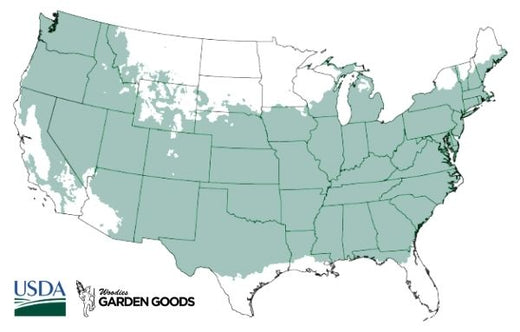
| Hardiness Zone: | 5-8 |
|---|---|
| Mature Height: | 12 to 15 feet |
| Mature Width: | 8 to 10 feet |
| Classification: | Small tree |
| Sunlight: | Part to full sun |
| Habit: | Deciduous, densely branched |
| Flower Color: | Insignificant |
| Foliage: | Green changing to purple-red to orange-red in the fall |
| Soil Condition: | Any well drained soil |
| Water Requirements: | Water well until established |
| Uses: | Extremely attractive when used as a focal point or a specimen planting, very slow growing |
How to Care for Lion's Head Japanese Maple
Be sure to read our planting instructions to ensure a healthy and happy Lion’s Head Japanese Maple plant for years to come!
How do I Plant a Lion’s Head Japanese Maple?
Planting a Lion’s Head Japanese Maple (Acer palmatum ‘Shishigashira’) begins with selecting the right location—choose a site with partial shade to full sun, ideally with protection from intense afternoon sun in warmer climates. This compact tree thrives in well-drained, slightly acidic soil rich in organic matter. To plant, dig a hole twice as wide and just as deep as the root ball. Gently remove the tree from its container, tease out the roots if they’re compacted, and position it in the hole so that the top of the root ball is level with the surrounding soil. Backfill with a mix of native soil and compost, then water thoroughly to settle the roots. After planting, apply a 2–3 inch layer of mulch around the base of the tree to help retain soil moisture, regulate temperature, and suppress weeds—keeping mulch a few inches away from the trunk to prevent rot. For best results, plant your Lion’s Head Japanese Maple in a location with good air circulation and shelter from strong winds, which can damage the delicate foliage. With proper planting and care, this slow-growing, upright maple will reward you with dense, sculptural foliage in spring and summer, followed by a stunning display of fiery fall color, making it a standout specimen in containers, borders, or Japanese-inspired gardens.
How do I Water a Lion’s Head Japanese Maple?
Watering a Lion’s Head Japanese Maple (Acer palmatum ‘Shishigashira’) correctly is essential for establishing healthy roots and maintaining vibrant foliage. During the first growing season, water deeply once or twice a week to keep the soil consistently moist but not waterlogged. Focus on watering at the base of the tree to avoid wetting the foliage, which can lead to fungal issues. A slow, deep soak encourages strong root growth and improves the tree’s long-term drought tolerance. Be especially attentive during hot or windy periods, which can dry out the soil more quickly. Once established, Lion’s Head Japanese Maple becomes more drought tolerant but still benefits from regular watering during extended dry spells or high heat. Always check the soil before watering—if the top 2–3 inches are dry, it’s time to water. Adding a 2–3 inch layer of mulch around the root zone will help retain soil moisture and protect the shallow root system from temperature extremes. Proper watering ensures this compact, ornamental tree maintains its dense, crinkled foliage and stunning fall color, making it a standout specimen in small gardens, containers, or Japanese-inspired landscapes.
How do I Fertilize a Lion’s Head Japanese Maple?
Fertilizing a Lion’s Head Japanese Maple (Acer palmatum ‘Shishigashira’) should be done carefully to maintain its compact shape and encourage healthy foliage without overstimulating growth. In early spring, before new leaves emerge, apply a slow-release, balanced fertilizer—such as a 10-10-10 formula—or a product specifically designed for Japanese maples or acid-loving plants. Spread the fertilizer evenly around the root zone, keeping it a few inches away from the trunk, and water thoroughly after application to help the nutrients absorb into the soil. Avoid high-nitrogen fertilizers, which can cause excessive, leggy growth and reduce the tree's natural compact form and vibrant fall color. For gardeners preferring organic methods, top-dress the soil with well-aged compost or a mix of composted pine bark and leaf mold to naturally enrich the soil. Fertilizing once per year is typically sufficient, as Lion’s Head Japanese Maple is a slow grower that thrives with minimal feeding. With proper fertilization, this elegant ornamental tree will display rich green foliage through the summer and transition into dazzling shades of orange, gold, and red in autumn—making it a standout feature in any garden.

How and When Should I Prune my How do I Plant a Lion’s Head Japanese Maple?
Pruning a Lion’s Head Japanese Maple (Acer palmatum ‘Shishigashira’) should be done sparingly and with precision to preserve its natural upright, compact form and dense, crinkled foliage. The best time to prune is in late winter to early spring while the tree is still dormant, just before new growth begins. Start by removing any dead, damaged, or crossing branches to open up the canopy and improve airflow. Avoid heavy pruning, as this slow-growing variety develops its sculptural shape over time and does not respond well to drastic cuts. Focus on thinning rather than shearing to maintain the tree's elegant structure. Minor touch-up pruning can also be done in summer to remove any stray or leggy growth that disrupts the tree’s clean silhouette. Use clean, sharp pruning shears and make cuts just above a healthy bud or branch junction. Refrain from pruning in late summer or fall, as this can stimulate new growth that may not harden off before winter. Proper pruning enhances the architectural beauty of the Lion’s Head Japanese Maple, allowing its dense foliage and strong branch structure to shine year-round. Whether grown as a focal point in the landscape or in a decorative container, careful pruning helps this tree maintain its refined and dramatic appearance.

